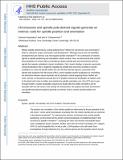| dc.contributor.author | Kiyomitsu, Tomomi | |
| dc.contributor.author | Cheeseman, Iain M | |
| dc.date.accessioned | 2018-06-15T15:00:38Z | |
| dc.date.available | 2018-06-15T15:00:38Z | |
| dc.date.issued | 2012-02 | |
| dc.identifier.issn | 1465-7392 | |
| dc.identifier.issn | 1476-4679 | |
| dc.identifier.uri | http://hdl.handle.net/1721.1/116335 | |
| dc.description.abstract | Mitotic spindle positioning by cortical pulling forces defines the cell division axis and location, which is critical for proper cell division and development. Although recent work has identified developmental and extrinsic cues that regulate spindle orientation, the contribution of intrinsic signals to spindle positioning and orientation remains unclear. Here, we demonstrate that cortical force generation in human cells is controlled by distinct spindle-pole-and chromosome-derived signals that regulate cytoplasmic dynein localization. First, dynein exhibits a dynamic asymmetric cortical localization that is negatively regulated by spindle-pole proximity, resulting in spindle oscillations to centre the spindle within the cell. We find that this signal comprises the spindle-pole-localized polo-like kinase (Plk1), which regulates dynein localization by controlling the interaction between dynein-dynactin and its upstream cortical targeting factors NuMA and LGN. Second, a chromosome-derived RanGTP gradient restricts the localization of NuMA-LGN to the lateral cell cortex to define and maintain the spindle orientation axis. RanGTP acts in part through the nuclear localization sequence of NuMA to locally alter the ability of NuMA-LGN to associate with the cell cortex in the vicinity of chromosomes. We propose that these chromosome-and spindle-pole-derived gradients generate an intrinsic code to control spindle position and orientation. | en_US |
| dc.description.sponsorship | National Institute of General Medical Sciences (U.S.) (Grant GM088313) | en_US |
| dc.publisher | Nature Publishing Group | en_US |
| dc.relation.isversionof | http://dx.doi.org/10.1038/ncb2440 | en_US |
| dc.rights | Creative Commons Attribution-Noncommercial-Share Alike | en_US |
| dc.rights.uri | http://creativecommons.org/licenses/by-nc-sa/4.0/ | en_US |
| dc.source | PMC | en_US |
| dc.title | Chromosome- and spindle-pole-derived signals generate an intrinsic code for spindle position and orientation | en_US |
| dc.type | Article | en_US |
| dc.identifier.citation | Kiyomitsu, Tomomi, and Iain M. Cheeseman. “Chromosome- and Spindle-Pole-Derived Signals Generate an Intrinsic Code for Spindle Position and Orientation.” Nature Cell Biology 14, 3 (February 2012): 311–317 © 2012 Macmillan Publishers Limited | en_US |
| dc.contributor.department | Massachusetts Institute of Technology. Department of Biology | en_US |
| dc.contributor.mitauthor | Cheeseman, Iain M | |
| dc.relation.journal | Nature Cell Biology | en_US |
| dc.eprint.version | Author's final manuscript | en_US |
| dc.type.uri | http://purl.org/eprint/type/JournalArticle | en_US |
| eprint.status | http://purl.org/eprint/status/PeerReviewed | en_US |
| dc.date.updated | 2018-06-14T15:16:09Z | |
| dspace.orderedauthors | Kiyomitsu, Tomomi; Cheeseman, Iain M. | en_US |
| dspace.embargo.terms | N | en_US |
| dc.identifier.orcid | https://orcid.org/0000-0002-3829-5612 | |
| mit.license | OPEN_ACCESS_POLICY | en_US |
